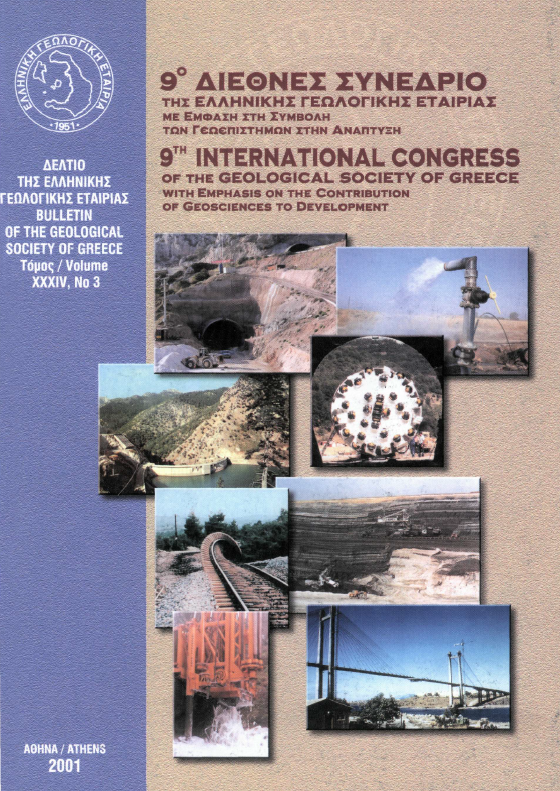CHEVRON-TYPE HALITE AND NODULAR ANHYDRITE IN THE TRIASSIC SUBSURFACE EVAPORITES OF THE IONIAN ZONE (WESTERN GREECE)
Abstract
Samples of the Ionian zone (western Greece) subsurface evaporites, obtained from well cores in salt bodies and in depths ranging from 1000 to 3500m, are texturally studied. Layered halite rocks consisting of chevron-type halite crystals represent most of the specimens. Between the chevron -type halite crystals, which are fluid inclusions-rich, clear halite without inclusions has been diagenetically formed by dissolution and precipitation processes. Anhydrite always accompanies the halite rocks as crystals or nodules. No-occurrence of gypsum has been detected. Along halite grain boundaries dolomite crystals occur. Dolomite grew on halite crystal surfaces as an early diagenetic mineral. Some dolomite crystals are clearly derived by replacement of anhydrite crystals. Halite layers are rich in clay and carbonaceous material favoring reducing environment (presence of pyrite crystals). Chevron-type halite supports accumulation beneath a body of brine, possibly recording annual precipitation cycles. However, its close association with nodular anhydrite cannot exclude the possibility of halite development, in a shallow-water or emergent environment by displacement from capillary brines. Since the studied halite crystals show evidence of mineral replacements and displacement, we suggest an analogous mechanism including accumulation from a standing body of brine and subsequent textural modification in the groundwater zone. Although, Ionian subsurface evaporites have undergone the above-mentioned diagenetical processes, they still reU in their primary textural characteristics. Real brecciation has not been detected in subsurface, except of an in-situ pseudo-brecciation. This observation clearly shows that the outcropping evaporite solution-collapse breccias were formed in the realm of meteoric zone, after the Ionian zone orogenesis.
Article Details
- How to Cite
-
Pomoni-Papaioannou, F., Karakitsios, V., Kamberis, E., & Marnelis, F. (2004). CHEVRON-TYPE HALITE AND NODULAR ANHYDRITE IN THE TRIASSIC SUBSURFACE EVAPORITES OF THE IONIAN ZONE (WESTERN GREECE). Bulletin of the Geological Society of Greece, 36(1), 578–586. https://doi.org/10.12681/bgsg.16755
- Section
- Petrology

This work is licensed under a Creative Commons Attribution-NonCommercial 4.0 International License.
Authors who publish with this journal agree to the following terms:
Authors retain copyright and grant the journal right of first publication with the work simultaneously licensed under a Creative Commons Attribution Non-Commercial License that allows others to share the work with an acknowledgement of the work's authorship and initial publication in this journal.
Authors are able to enter into separate, additional contractual arrangements for the non-exclusive distribution of the journal's published version of the work (e.g. post it to an institutional repository or publish it in a book), with an acknowledgement of its initial publication in this journal. Authors are permitted and encouraged to post their work online (preferably in institutional repositories or on their website) prior to and during the submission process, as it can lead to productive exchanges, as well as earlier and greater citation of published work.








